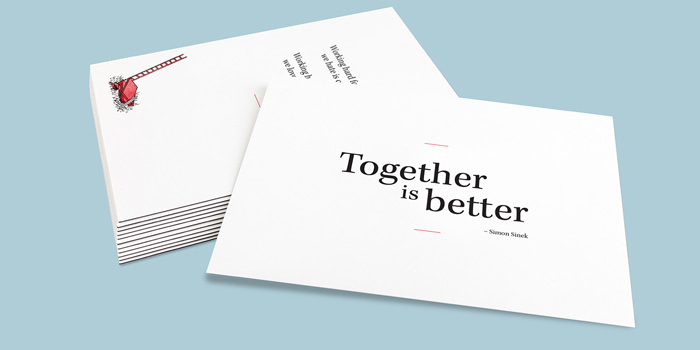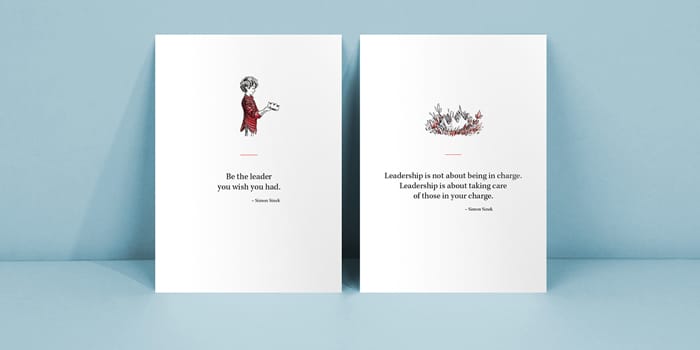MOO + Simon Sinek: working together
Why together is always better

Speaking with Simon Sinek isn’t an experience you forget quickly. His enthusiasm, his belief and his unstoppable optimism shine through every part of our conversation – it’s fast, free-flowing and fun.
We caught up with him to find out more about the ideas that make him tick, his collaboration with MOO and get his latest advice for surviving today’s busy workplace.
Together is better
Simon became widely known following his hugely popular TED talk, How Great Leaders Inspire Action. His distinctive approach – applying behavioural psychology and evolutionary thought to the modern workplace – was captured in his bestselling books Start With Why and Leaders Eat Last. Now, his new book Together is Better, takes a different tack.
Together is Better, challenges its readers to step outside our usual workplace behaviours. It explores cooperation, collaboration and leadership – but here’s the twist – it does so in the style of a fable. An illustrated storybook might not feel the most obvious way to talk about the workplace, but, argues Simon, that’s exactly why it’s a successful format here. “When we teach children,” he explains, “we teach with metaphors and analogies. Stories are more beautiful and the lessons easier to learn. “As adults, it’s really uncomfortable to talk about work and whether or not you’re really happy. To talk about it with a metaphor made it more disarming, and made more of us open to the message. I care more about the message than anything else.”
Safety to take risks
One of the subjects covered in the book is the importance of feeling safe at work. “Safety is a human requirement,” he elaborates. “At work, it’s the comfort to say ‘I don’t know what to do’ without the fear you’re going to get yelled at. That feeling is woefully rare.” This stems, Simon argues, from a lack of a clear purpose, from short-sighted actions for immediate results – from, in short, a lack of good leadership. “Leadership is supposed to provide the vision, long-term,” he says. “A vision is a description of a world that does not yet exist – and if everything we do goes well, we will contribute to building that world. That’s vision.”
So where does safety fit into this? Because when people feel safe, they feel able to take risks. It’s only from a position of safety that we have our chance to learn. And this requires, for a leader, a commitment to both short- and long-term thinking. “It’s the difference between going to the dentist once and brushing your teeth,” Simon elaborates. “If you go to the dentist, your teeth feel fantastic – but if that’s all you do, they’ll fall out. Brushing twice a day, that’s what keeps them clean. “But just brushing your teeth for 2 minutes? It does nothing! It’s not about consistency or intensity – it’s both. That’s why we have so much bad leadership – we favour the short-term. We rely on intensity and forget about consistency.”

Advice for leaders
As leaders, transferring this big-picture advice to day-to-day working life isn’t always easy. Deadlines can mount up, to-do lists can feel a mile long and it can be tough to keep our eyes on the purpose whilst staying motivated. If this happens, Simon’s advice is clear. “Ask for help,” he insists. “You don’t have to know all the answers, or even pretend you do. When you admit you don’t know something, there’s a whole group of people who are so willing to help. The only reason they haven’t already is they didn’t think you needed it – because you were too busy lying, hiding and faking.”
These postcards are little billboards. There to remind you why it’s all worth it.
And at times of stress, reminders that we work better together can be really valuable. With that in mind, we collaborated with Simon on a set of postcards, inspired by Together is Better. “These postcards are little billboards,” Simon explains. “It’s something to sit on your wall, your corkboard or your desk. These cards are there to remind you, when you’re stuck in a lot of short-term goals, of to-do lists and phone calls, why it’s all worth it.”
Always have a vision
Simon writes that we need to plan for the fact that nothing goes to plan. But, he argues, when you know where you’re heading in the end, this needn’t derail your adventure. This difference comes in the vision that your company has. “Here’s the difference in having a plan but no vision,” he explains. “When you ask a company why they’re doing what they’re doing, they say growth. That’s like asking someone where they’re going on holiday, and they say ‘I’m taking the M5.’ “They’ve got all kinds of goals, but no destination. They set out saying they’ll drive 100 miles a day, then get overexcited when they do 130. But what if there are roadworks?”
Whereas, he explains, with a clear destination in mind, like saying you’re on the road to Scotland, it doesn’t matter if you have to take a side road. Even if it looks like you’re going in the wrong direction, you still know where you’re heading. “Plans are important, but they’re very dangerous if you don’t know where you’re going. You can count on there being millions of unforeseen things that will throw you off-plan. You have to be able to adjust – not stop driving to Scotland simply because there are roadworks.”

Losing your passion
Simon’s ideas and approach to leadership come directly from his own experiences. When asked about how he became an author and speaker, he smiles, “I’m an accidental tourist here.” For 4 years, he ran his own consultancy, with the self-propelled passion that most owner/founders will find familiar. But, like many in that position, he found it simply wasn’t a sustainable way to work. “The difference between small organisations and big ones is that small organisations can run on the force of one person,” he explains. “My business ran on personality, but by year 4 we’d grown to such a size where we needed structure and help. I felt I had to have all the answers, and if I didn’t, I pretended that I did.” This, as Simon found, quickly becomes a tough place to be. “I lost my passion,” he admits. “I didn’t want to wake up and do it again, so I invested my energy in pretending I was happier.”
Be open to change
“I ran into a brick wall and realised that direction was no longer open to me,” Simon explained. “But instead of crying that my road was blocked, I was open to taking a different direction.” It was this change in direction that took him to where he is now – and inspired many of the people around him to make radical changes too. “My solution was the discovery of the ‘why’. It gave me a clarity and confidence I’d never had. I shared it with my friends – they started making crazy life changes too.” And before long, this ‘obsession’, as Simon calls it, with purpose, became his new passion. And now, of course, his new job too. “Anyone can achieve something if they’re open to it,” he insists. “Those choices are available to all of us – if you remember that you can’t do it alone.” And that, we think, is something worth remembering every day.
Need another Simon Sinek fix? Check out our summary of his seminal TED Talk.
Bringing a new employee onto your team can feel a lot like leading a freshman orientation. You’ve got to show the new kid the ropes, make them feel part of an amazing group, and get them keen to do their best work. As someone in HR, you have the power to make their transition a little easier— and a lot more fun. How? Start with an onboarding kit.
An onboarding kit is essentially a care package for the newest member of your office. It helps them understand what your company stands for, and shows the new hire that you’ve got their back.
We found representatives from some of the most welcoming companies on the planet, and asked what goes into their kits.
Percolate
When a new brand grows quickly, it can be difficult to teach every new hire about the office’s culture. Noah Brier, the co-founder of Percolate, experienced this in 2013 when his company added 60 new people. At this point, the exec started to take a closer look at Percolate’s onboarding process.
“Your first week at a company has an outsized impact on how you feel about the organization, how you get yourself ramped up and how effective you will be,” Brier said in an interview with First Round Review.
In other words, first impressions are everything. That’s why an onboarding kit can mean the world to a new employee— it helps them feel a part of the team by highlighting what their culture is all about.
Here’s a glamor shot of Percolate’s onboarding kit:
This desk is arranged beautifully, which reflects the company’s emphasis on great design. “You walk in the door and you’ve got a desk full of everything that you need to get started,” said Brier.
This swag stash also includes a T-shirt, coffee mug, granola, tote bag and Kindle. “That’s linked to a core idea that we are a learning organization,” Brier says. “It’s our responsibility to help encourage people to continue to read and make themselves better.” Sign us up.
Ogilvy & Mather
Ogilvy & Mather calls their onboarding kit an induction box, but the purpose is the same – get the newbie clued up on what it means to work for one of the biggest advertising agencies in the world.
Every detail of this gift tells the new employee something about the agency. For example, the copy inside the lid reflects Ogilvy and Mather’s playful nature, and encourages team members to think outside the box. (Well, from inside the box… you know what we mean.)
Even if a new hire knew nothing about Ogilvy, this box would provide a detailed history and suggestions for the future. Its design concept is drawn from David Ogilvy’s book,The Eternal Pursuit of Unhappiness, as well as his eight habits of highly creative communities.
All of these items highlight the importance that Ogilvy places on greatness. For example, a postcard reads “Here, we have a habit of divine discontent. It’s an antidote for smugness.” In two short lines, they’ve summarized their brand’s culture.
“Getting new staff to understand and embrace all of this in a fun and engaging way was our main focus,” an Ogilvy Cape Town representative says in an interview with AdWeek. “The Induction Box solidifies the importance of what we stand for.”
HUGE Inc.
You know a company has some serious brand culture going on when they have over 600 likes on Instagram for a picture of something in their onboarding kit.
When a new employee at marketing agency Huge Inc. gets this on their desk, they know they’re working for a team that is playful, hardworking, and sassy as all get out. The onboarding kit includes a tote bag, branded pencils, a gift card to a local coffee shop, and candy.
“Culture is everything to us and it only becomes more important as Huge grows in size and across cities and countries,” says Adrian Buendia, a senior recruiter at Huge. “As an employee, you’re here to create amazing things with amazing people.”
Customized Business Cards, company Stickers, and Postcards printed with your company motto are a great place to start building your onboarding kit. From there, think about how you can convey your brand’s voice. Are you playful? Throw in a company coloring book. Design-centric? Add some graphite pencils.
Overall, make sure you follow the advice of Adrian Buendia from Huge: “We want our people, no matter what role they are in, to reflect us in the world around them.”
Want to create an onboarding kit for your new hires? Fill out the form below to learn more about MOO Business Services.
Get in touch
At MOO, we’ve been helping people make their mark in the world with amazing quality print products for over a decade. And as our customers have grown, so has our service offering. That’s why for bigger businesses—with 10+ employees—we now offer MOO Business Services. It’s MOO + benefits. MOO Business Services combines dedicated account management with an easy online ordering platform and expert design services. It’s a complete package for businesses to give you more brand control and consistency—while saving you time, stress, and money in the process.


